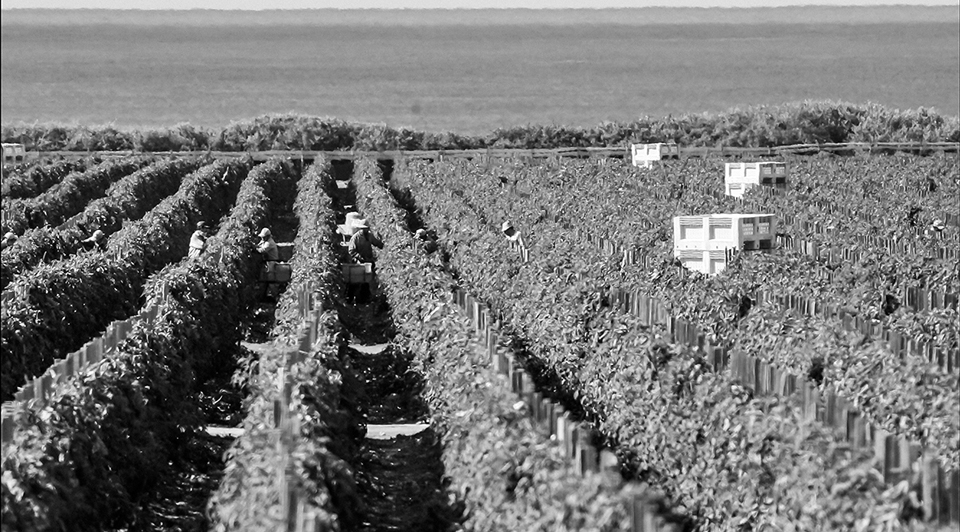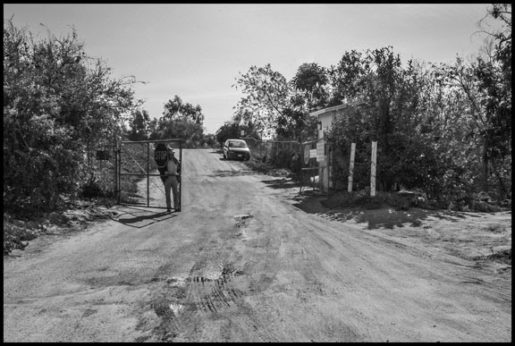
Many migrant workers in California on H-2A temporary agricultural visas are forced to contend with unsafe working conditions, wage theft and other labor law violations. The H-2A temporary agricultural program allows employers to bring workers from other countries, mainly Mexico, for temporary farm labor in the U.S. The workers are given visas that allow them to work in the U.S. but tie them to the employer that recruits them. Part 2 of this story documents migrant workers housed like sardines, and the use of immigration enforcement to expand the H-2A visa program.
Capital & Main is an award-winning publication that reports from California on economic, political, and social issues. The American Prospect is co-publishing this piece.
Tomato grower Harry Singh had an idea for speeding up the harvest in the fields he rents at the Camp Pendleton Marine Base near San Diego. His foreman told Serafín Rincón, 61, to pick beside two imported contract workers in their 20s. In the summer heat, Rincón was told to run. He could hardly keep up.
Rincón had come to work with his friends Santiago Bautista and Rufino Zafra They were all longtime farm workers in the area. Bautista had been working in San Diego since 2003, and Zafra since 1975. All day they had to listen to gritos(shouting) and insults from their boss Celerino when they fell behind. “Stupid donkey, you’re old now,” he shouted at them. “You can’t make it anymore!”
The three even started trying to hold it when they had to go to the bathroom, after being yelled at for going too often. Not that using those bathrooms was a pleasant experience. The toilet paper ran out so often they started bringing their own from home. Zafra would even wipe down the filthy port-a-potty with paper towels. The drinking water tasted like “hot soup,” Bautista said. He had a heart attack at work, but still the foreman wouldn’t let him stop working. A medical examiner said later the attack was caused by his working conditions.
Finally Rincón was fired, and the three sued Harry Singh’s company, West Coast Tomato, over the abuse.
Singh was one of the first growers to bring H-2A temporary agricultural workers to California. These young, mostly male workers are recruited in other countries, mainly Mexico. They’re given visas that allow them to work in the U.S. but tie them to the employer that recruits them. “Many of the younger workers whom our plaintiffs had to keep pace with were H-2As,” explained Jennifer Bonilla of California Rural Legal Assistance. She introduced expert testimony of Dr. Kenneth Silver, who tied the speed-up of the production requirements given the younger H-2A workers.

The U.S. Department of Labor allows growers to put production quotas into the contracts under which workers are recruited to come to the U.S., and to fire workers for not meeting them. If H-2A workers get fired before the end of their contract, they lose its guaranteed weeks of work and pay. They also become immediately deportable. The grower doesn’t even have to pay their transportation to the border, much less to the town they came from.
That gives a grower a lot of leverage to get workers to work at an inhuman pace. And because the H-2A workers can be forced into it, workers who are living in the U.S., and laboring at the same job, get pressured into it as well. Humiliation, firings, and even heart attacks are the result.
The Impact of the Explosive Growth of H-2A
This is just one impact on farm workers in California of the explosive growth of the H-2A guest visa program. Like everything connected to the state’s agriculture, it’s big business. In 2016-an enormous production of food that has little to do with agribusiness’s oft-declared goal of “feeding the nation”: Almost half of what’s grown here leaves the country in exports worth $20 billion.
Employing at peak season almost three quarters of a million people (719,000 in 2017 in California alone), this enormous industry needs workers. The growth of a captive, low-wage and vulnerable workforce at its heart has a profound effect, not just here, but across the nation.
Growers applied to the U.S. Department of Labor for certification to bring 44,619 H-2A workers into U.S. fields in 2004. Last year the number certified had grown to 200,049-over 450 percent in a little over a decade. California growers brought in 3,089 H-2A workers in 2012. In 2017 that had mushroomed to 15,232-a 500 percent increase in just five years.
The impact of guest workers will grow even more severe if Congress passes a bill (H.R. 4760, Securing America’s Future Act) that would not only put H-2A on steroids, but would do away with what little (mostly unenforced) protections currently exist for farm workers, both resident and recruited. Farmworker Justice, an advocacy group for farm workers in Washington, D.C., calls the bill a “virulently anti-immigrant and anti-worker piece of legislation.” And four cabinet secretaries in the Trump administration have already promised growers to make the H-2A program more grower-friendly.
Growers claim that because of increased border enforcement, the number of available farm workers is falling, although the industry employed virtually the same number, 724,000, 20 years ago. “There is a severe ag labor shortage, and it’s only going to get worse,” wrote Tom Nassif, president of the Western Growers Association, on the WGA webpage. “Changing demographics and stringent regulatory barriers are causing the flow of workers crossing the border to dramatically slow down.” The Department of Labor estimates that about half of U.S. farm workers are undocumented, and in California the percentage is higher.
Unemployment in California’s farm worker towns, however, is always much higher than in urban areas. In April, for instance, the unemployment rate in Imperial County was 14.4 percent, in Merced County 8.7 percent, and Monterey County 6.7 percent. (In Los Angeles, it was 4.1 percent and San Francisco, 2.1 percent.) Yet according to Nassif, “Increased pay and overtime benefits aren’t going to attract any additional workers to the field. Those extra workers don’t exist.”
In reality, farm wages have been falling since the late 1970s, when the United Farm Workers was at its peak strength, and the base labor rate in union contracts was twice the minimum wage.
In reality, farm wages have been falling since the late 1970s, when the United Farm Workers was at its peak strength, and the base labor rate in union contracts was twice the minimum wage. Even non-union employers had to compete for workers by paying union wages. Today the average wage of California farm workers is just above the minimum wage-$11.68/hour by one estimate. The H-2A program, critics charge, allows growers to keep wages low, giving them an alternative to raising pay to attract labor.
Another CRLA case against Harry Singh dramatized the way West Coast Tomato could pit H-2A workers against local laborers to reinforce low wages and unsafe working conditions. The suit, Espinoza et al. v. West Coast Tomato Growers, accused the company of evading two legal requirements-that it hire local residents before recruiting H-2A workers, and that it pay local workers at least as much as it pays the imported laborers. CRLA’s plaintiffs included Elisa Valerio, Guillermina Bermudez, and Felix Gomez, experienced local farm workers employed in the West Coast Tomato packing shed.

Once tomatoes are picked, they’re brought into a hot cavernous building where they’re sorted on high-speed conveyor belts. The three workers described intense pressure to maintain a very fast work pace, much like what Rincón experienced in the fields.
Both local and H-2A workers did the same work. West Coast Tomato, however, called the H-2A workers “packers” and the resident workers “sorters.” Its application to the Department of Labor claimed it couldn’t find local “packers” and therefore needed to fill jobs in the shed with H-2A workers. West Coast would hire only local workers as “sorters.”
Then the company paid sorters less than the H-2A wage. This rate, called the Adverse Effect Wage Rate (AEWR), is set every year by California’s Employment Development Department. In 2014 it was $11.01/hour. The three workers, however, were paid the minimum wage-$8/hour until July 2014, and $9/hour afterwards-because they were “sorters” and not “packers.”
Both the older local workers and younger H-2A contract laborers had to meet high production quotas. If the line stopped, the three plaintiffs said, the company docked their pay until it began again (a violation of state law). And when it was running they couldn’t even leave to use the bathroom. Valerio, Bermudez and Gomez couldn’t keep up and were fired in August 2014.
U.S. District Court Judge Thomas Whelan rejected West Coast’s classification scheme, saying it allowed the company “to hire H-2A workers as ‘tomato packers’ without a legitimate shortage of qualified Americans and pay them more per hour than its American equivalent ‘tomato sorters.'”
CRLA Litigation Director Cynthia Rice charged, “It’s good that we can win these cases and get justice for some workers, but it’s a small number compared to the total number of H-2A and affected resident workers in the California workforce.”
H-2A workers cheated and housed like sardines
A legal challenge in Santa Maria, also brought by CRLA, highlighted the cost of the H-2A program to the H-2A workers themselves. In 2013 a pair of recruiters showed up in the Mexican state of Michoacán, promising jobs in California with free housing and transportation. To get the jobs, however, recruits had to pay a deposit of $1,500 each into the bank account of labor contractor Jorge Vasquez.
Charging recruitment fees is a violation of federal H-2A regulations. Nevertheless, Jose Raul Gonzalez, Efrain Cruz, Ana Teresa Cruz and Rosaura Chavez paid the money and went to Tijuana to wait for their visas. There they were taken to a house where 12 recruits slept in each room. The workers had to wait six weeks before they finally crossed the border. Then their passports were taken away. Their recruiter, Vasquez’s nephew Diego, said they’d get them back only after they came up with an additional $1,500.
Vasquez told them they couldn’t leave the residence except to go to work, threatening them with deportation and saying he could hurt their families in Mexico.
The four wound up in Santa Maria picking strawberries, housed in a two-bedroom residence with 14 to 16 other H-2A workers. Each paid $80 a week for housing and food-another legal violation. Vasquez told them they couldn’t leave the residence except to go to work, threatening them with deportation and saying he could hurt their families in Mexico. Every day they were dropped off at the fields at 4 a.m. and worked until 3 to 5 p.m. They picked 30 to 35 boxes of berries a day, at $1 per box, but their first week’s pay was only $200. They were paid in cash, with no pay records. At the AEWR wage at the time, they should have been paid $721.
The second week they weren’t paid at all. Instead, they were told their pay was going towards their $1,500 “debt.” When Chavez asked to leave, Diego told him that he had to continue working until the debt was paid. Finally one of them escaped. The other three worked for two more weeks. After each deposited $1,500 into Vasquez’s account, they were fired and thrown out of the house.
On May 17 Vasquez and two others were indicted by the Department of Justice and arrested for charging workers for visas and making false promises that the visas would last for three years. Since 2012 they have filed petitions for over 350 workers.

Bad housing conditions for H-2A workers are not unusual. Last October the city of Santa Maria filed suit against a local slumlord, Dario Pini, over extreme violations of health and housing codes in hundreds of apartments in eight complexes. One of them, the Laz-E-Daze Boardinghouses at 1300, 1308, 1318 and 1324 North Broadway, is used as housing for H-2A workers. There city inspectors cited Pini for “deteriorated concrete walkways, accumulated trash, abandoned inoperable vehicles, plumbing leaks, unpermitted construction work, bedbug infestation, cockroach infestation, lack of hot water, faulty and hazardous electrical systems and broken windows and missing window screens.”
Two H-2A labor contractors list 1318 North Broadway as company housing in their applications for certification by the Department of Labor. Big F Company says 80 workers live there, and Savino Farms has 60 more. Other certification forms list even more questionable housing. La Fuente Farming Inc. lists one small dwelling at 403 W. Creston St. as housing for 14 workers. A completely tumble-down derelict trailer next to a strawberry field at 1340 Prell St. is listed as housing for six workers, also by La Fuente Farming. There is no record that the Department of Labor or the Employment Development Department actually examined the housing employers said they were providing.
Meanwhile, Santa Maria rents are rising. According to CRLA attorney Corrie Arellano, growers and contractors bring about 800 workers into the Santa Ynez Valley each year. “At first they filled up almost all the inexpensive motel rooms in town,” she said. “Now they’re renting out houses and apartments, and pushing up rents.” Francisco Lozano, a Mixtec farm worker and community activist, and longtime Santa Maria resident, says his rent for a two-bedroom apartment has gone from $1,000 to $1,300 in three years. Mixtecos are an indigenous population in Mexico, whose language and culture long pre-date European colonization. A large percentage of California farm workers today are migrants from Mixteco and other indigenous Mexican towns.
“Our Mixteco community is upset for two reasons,” he explained. “We struggled with the school district to get them to hire a Mixtec-speaking translator for our children, some of whom don’t speak Spanish. But the new H-2A workers are all single men who leave after the harvest is over, so they have no stake in the schools or our families. In addition, Mixteco farm workers used to organize short strikes at the beginning of every picking season to push up piece rates and wages. Now people are afraid that if we do that the growers will bring in H-2A workers. I think H-2A is a kind of modern slavery.”
Similar community concerns are reflected in a study of housing conditions in Salinas made by demographer Rick Mines, “The Social Impact of the H2A Program in the Salinas/Pajaro Valleys.”
“There is a growing competition between the new migrants (the H-2A) and the old (the settled Mexican families),” he says. “This competition affects the availability of housing as the older migrants face higher prices and increased crowding in the apartments where most live. But, more importantly perhaps, the older settled workers will be getting less work as their younger co-nationals (the H2A) replace them in the fields.” By one estimate, half of the strawberry workers in the Salinas-Watsonville area are H-2A workers.

In Salinas two of California’s largest vegetable growers, Tanimura & Antle and the Nunes Company, are building new worker housing. These complexes are similar to those being rapidly constructed by growers in Washington state for their H-2A workers. While the Tanimura complex, with 800 beds, was made available to local residents, and the Nunes family says it may do the same with its 600 beds, both complexes eventually will likely become housing for H-2A workers. Tanimura already brings 800 H-2A workers into Yuma, Arizona, every year.
The regulation that originally required each employer to advertise jobs to local residents first, and allowed them to recruit H-2A workers only if there was no local labor available, has been drastically altered. Today labor contractors are allowed to apply for certifications, recruit workers and then move them from grower to grower, field to field. In effect, these contractors employ a flexible labor pool they place at the disposal of many growers. The assertion that they’ve tried to find local labor is just that-an unchecked assertion.
Last year Fresh Harvest Inc. was certified for 4,623 H-2A workers, and Elkhorn Packing Co. for 2,653. Fresh Harvest calls itself “one of the largest H-2A employers in the Western United States.” Its website has a special section where potential recruits in Mexico can register, with a schedule of recruitment events at offices in San Quintín, Baja California, and Zamora, Michoacán. Fresh Harvest manages the recruitment, certification and visa processing for growers, sets up housing, trains workers, files all government reports, and provides worker transportation. “We insist on taking an active role in the in-field/job site management of our employees,” the site claims. The company’s owner, Steve Scaroni, predicts that this year Fresh Harvest will bring over 7000 workers into California, Arizona, Nevada, Oregon, and Colorado, housing them in motels, apartments and labor camps.
Elkhorn Packing’s website describes the company as “a leading custom harvester with operations in the Salinas Valley, Santa Maria, El Centro, and Yuma regions.” With a contract labor force of thousands of H-2A workers dispersed that widely, it is unlikely that the individual growers whose fields it harvests have each determined separately that no local workers are available.
Using immigration enforcement to expand H-2A
While growers’ use of the H-2A program has increased sharply, immigration raids in rural areas of California have increased as well, especially following the election of President Trump.
While growers’ use of the H-2A program has increased sharply, immigration raids in rural areas of California have increased as well, especially following the election of President Trump. The high visibility of the Border Patrol in farm worker towns was dramatized in March by the deaths of an immigrant couple in Delano, who crashed their van while fleeing in terror from immigration agents. Over the last six months the Department of Homeland Security has initiated document checks leading to the firing of hundreds of workers at several large San Joaquin Valley farms, including Pitman Family Farms and Poindexter Nut Company in Sanger, Bee Sweet Citrus in Fowler, and Fresh Select in Dinuba.
Grower concern about maintaining a stable workforce has been exacerbated by threats from the President to build more border walls, and to use the E-Verify database to identify undocumented workers for termination or deportation. WGA President Nassif, who belongs to Trump’s agricultural advisory board, argues that this increased immigration enforcement is restricting the number of immigrant workers. That complaint, in turn, provides a rationale for expanding the H-2A program, reducing its requirements, and even redrafting the contract labor scheme entirely.
Replacing undocumented workers with H-2A recruits is not a new idea. In 2010 immigration authorities went through the payroll records of one of Washington State’s largest apple growers, Gebbers Farms, and identified 550 people they said had no legal immigration status. After the company fired them, it was then encouraged to use the H-2A program. According to Gebbers manager Jon Wyss, “Our first year, we hired 300 workers from Jamaica and 750 workers from Mexico for a total 1,150 H-2A workers.” By 2017 Gebbers was bringing more than 2,000 H-2A workers, Wyss testified to the House Immigration Subcommittee.
That committee was considering a bill sponsored by Virginia Republican Congressman Bob Goodlatte, chair of the Judiciary Committee, called the Agricultural Guestworker Act. Goodlatte explained its goal: “A reliable, efficient, and fair program that provides American farmers access to a legal, stable supply of workers … [in] a new, flexible, and market-driven guest worker program.”
That bill would have provided employers with 450,000 workers yearly under a new H-2C visa at states’ minimum wages, or 115 percent of the federal minimum of $7.25 an hour. Ten percent of workers’ wages would be withheld, and could be collected at the U.S. consulate only after returning to their home country. The proposal would have eliminated requirements that growers provide transportation and housing, and allowed them to employ guest workers year around, so long as they returned to the border every year to “touch back” before returning to their jobs.

In January, Goodlatte incorporated the guest worker bill into a larger immigration bill, the Securing America’s Future Act. It would eliminate family-based visas for parents, children, brothers and sisters of legal immigrants and citizens. Guest workers would be prohibited from bringing their families with them. All employers would have to use the E-Verify system to identify and fire all undocumented workers.
“The White House right now is fully committed to the Goodlatte bill and trying to pass [it] out of the House,” a spokesperson told the Washington Times in February. President Trump owns a Virginia vineyard that employs H-2A workers, and won strong support from rural agricultural areas of California increasingly dependent on guest worker labor. Some of the state’s most powerful Republican congressmen have roots in agribusiness, including Jeff Denham, Devin Nunes, and David Valadao. The House Majority Leader, Kevin McCarthy, represents Bakersfield and Kern County.
The Western Growers Association declined to support the Goodlatte bill, saying its touch-back provision was unworkable and its 410,000 annual guestworker limit too low. However, H-2A contractors like the Washington Farm Labor Association (WAFLA) are optimistic. “We are very positive about the Trump administration. I was in D.C. in December and met with the transition team, and our industry lobbyists have followed up,” WAFLA head Dan Fazio told a meeting of growers not long after the election, the Seattle Times’ Hal Bernton reported. “I don’t think there is a person in this room who voted for President Trump who wouldn’t vote for him again tomorrow.”
The Trump administration isn’t simply waiting for Congress to decide on the Goodlatte bill. On May 24 the secretaries of Agriculture, Homeland Security, State and Labor issued an “H-2A Agricultural Worker Visa Modernization Joint Cabinet Statement” promising to change the program rules “in a way that is responsive to stakeholder concerns and that deepens our confidence in the program as a source of legal and verified labor for agriculture.” While the promise is unspecific, changed regulations could do away with guarantees of housing and transportation, AEWR wage rates, and protections for resident farm workers-all changes growers have advocated. The statement also says the administration “plans to incentivize farmers’ use of the E-Verify program.” Requiring growers to use E-Verify to identify undocumented employees and fire them could lead to hundreds of thousands of workers losing their jobs, given that about half the farm labor workforce of two million people have no legal immigration status.
United Farm Workers national vice president Armando Elenes, however, condemned the political agenda that combines increased immigration enforcement with rising use of the H-2A program. “There’s a huge explosion of H-2A in California,” he said. “ICE does audits and raids, and then growers demand changes that will make H2-A workers even cheaper, by eliminating wage requirements or the requirement that they provide housing. Reducing the available labor and the increased use of H2-A are definitely connected.”
Like free stuff? So do we. Here at People’s World, we believe strongly in the mission of keeping the labor and democratic movements informed so they are prepared for the struggle. But we need your help. While our content is free for readers (something we are proud of) it takes money — a lot of it — to produce and cover the stories you see in our pages. Only you, our readers and supporters, can keep us going. Only you can make sure we keep the news that matters free of paywalls and advertisements. If you enjoy reading People’s World and the stories we bring you, support our work by becoming a $5 monthly sustainer today.










